5 Foods to Incorporate into Your Fall Diet
Did you know recent research provides evidence that eating 10 servings of fruits and vegetables per day is best in preventing chronic diseases and premature mortality? In 2015, 12% of adults in the U.S. met the fruit recommendation and only 9% met the vegetable recommendation.
The current dietary recommendations for adults in the United States are 1.5-2 cups of fruits and 2-3 cups of vegetables per day.
Reading this now, 10 servings may seem surprising, it may even seem somewhat overwhelming. How will I eat 10 servings of fruits and vegetables every day? First, don’t panic. Any amount of fruits and vegetables you eat per day is beneficial to your health, just know the more you consume on a daily basis the more health benefits you’ll receive. Second, figure out where you are at with your current consumption. Are you eating fruit every day? What about vegetables? Once you have a starting point you can start to make changes and increase your intake! Third, instead of worrying about measuring out 10 servings of fruits and vegetables, keep it simple. Start to make half your plate fruits and vegetables for breakfast, lunch, and dinner.
Below you will find 4 in-season fruits and vegetables, and 1 spice, to get you started in eating more fruits and vegetables!
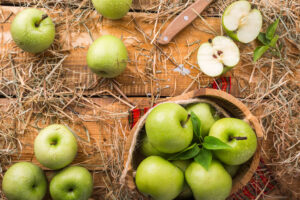
Apples
“An apple a day keeps the doctor away”. All fruits are nutritional powerhouses, especially apples! Apples contain dietary fiber, phytonutrients, B vitamins and antioxidants like vitamin C. These awesome nutrients found in apples help fight off free radicals in your body. Free radicals can cause oxidative stress which is thought to play a role in a variety of diseases including cancer, cardiovascular disease, Parkinson’s disease, Alzheimer’s disease, diabetes, and more. Try the tips below to easily add apples to your diet!
- Have an apple alongside your breakfast every morning. Diced apples in oatmeal or cold cereal, on the side with yogurt or cottage cheese, or add sliced apple on your peanut butter toast.
- Add an apple to your lunches. Sliced apple on whole grain bread with turkey and brie, cut up atop a salad, or chopped apple added to tuna salad.
- Have an apple as a snack. Pair an apple with peanut butter or another nut butter, have an apple with a handful of nuts or even with a string cheese.
- Incorporate apples as a festive side dish to dinner. Roast sliced apples in the oven on a baking sheet and pair with baked chicken, fish, or place it on top of a salad.
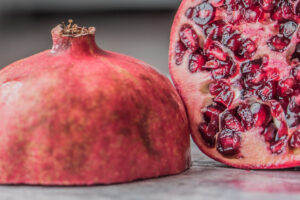
Pomegranate
Another nutritional powerhouse is pomegranate! The actual skin of the pomegranate is not edible but found inside are hundreds of edible seeds. The seeds are surrounded by a juicy and sweet covering known as an aril. The arils have an impressive nutrient makeup – fiber, protein, vitamin C, potassium, vitamin K, and folate! Similar to apples, pomegranates may help to lower your risk of all kinds of disease including cancer, diabetes, chronic inflammation, heart disease, high blood pressure, arthritis, and more. So how can I add more pomegranate into my diet? Check out the tips below!
- Scoop out the seeds and add it to your breakfast. Instead of adding raw sugar or honey to yogurt or oatmeal, add arils to sweeten up your meal! Arils are also delicious on avocado toast.
- Pack a pomegranate to work as a snack! Scoop out the seeds and add it to sliced avocado or a piece of cheese as a mid-morning or afternoon snack.
- Sweeten up your lunch. Add the seeds to a salad with spinach, pistachios, crumbled goat cheese, peppers, and an orange. Pair with chicken or tuna salad to satisfy your sweet craving!
- Add it to your dessert. Pomegranate is very versatile and pairs well with all kinds of desserts. Add the arils with pistachios to the top of a carrot cake, baked inside brownies, or mixed in with pudding.
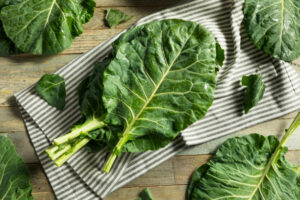
source:istock
Collard Greens
Moving onto vegetables, collard greens are an excellent source of vitamin A, vitamin C and folate, a good source of fiber and calcium, and low in calories coming in at about 20 calories per 2 cups! Adding collard greens to your plate is a great way to make your meals more nutrient dense and help you to feel full and satisfied quicker. Unsure what to pair collard greens with? Follow the tips below!
- Add collard greens to your breakfast. Adding vegetables to breakfast is only weird if you make it weird! Place steamed collard greens over a piece of high fiber, whole grain bread with a ¼ cup of feta cheese or sautéed in scrambled eggs.
- Sizzle em’ in a stir fry. Add collard greens to a stir fry for lunch or dinner with garlic, olive oil, peppers, onions, brown rice, and your choice of protein.
- Swap out lettuce for collard greens. Collard greens can be used in place of any dark green leafy vegetable – add it to your salad, tacos, wrap, or on top of a sandwich.
- Have them as a side dish. Make half your plate vegetables by mixing 2 cups of collard greens with low sodium chicken broth, garlic, and a dash of salt in a saucepan, simmering on low heat.
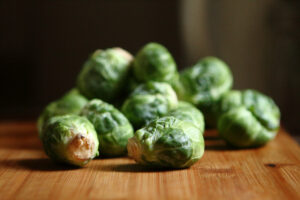
Brussel sprouts
Another vegetable to add to your fridge this Fall is brussel sprouts. Brussel sprouts are low in calories, high in vitamin C, and a good source of dietary fiber and folate! Did you know fiber is one of the most under consumed nutrients in the U.S.? Every fruit and vegetable in this article is a good source of fiber! Check out the list below to find ways to add it in this season.
- Make a brussel sprouts hash! Sizzle brussel sprouts with olive oil in a pan with onions, peppers, and garlic. Pair with scrambled, over easy, or sunny side up eggs for a delicious breakfast.
- Add brussel sprouts to lunch. Add steamed or roasted brussel sprouts to pasta, mac and cheese, as a side with your sandwich, or to your salad for more flavor and texture.
- Roast em’ for dinner! Roasting fall vegetables like brussel sprouts is a great way to add more flavor to your meals. Add fresh, halved brussel sprouts to a baking sheet with 1 tablespoon of olive oil drizzled on top with garlic cloves and sprinkled parmesan cheese. Bake for 15-20 minutes and add it as half your plate for dinner paired with a protein and whole grain such as chicken and quinoa.
- Have brussel sprouts as a dessert in just 5 minutes. Dust brussel sprouts with olive oil, 1 teaspoon of brown sugar, and a pinch of salt. Microwave for 5 minutes. To add even more crunch and flavor, top with a scoop of pomegranate seeds.
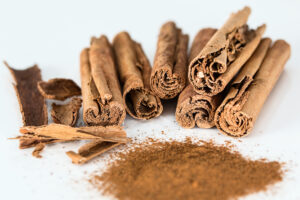
Cinnamon
Cinnamon comes from the bark of the cinnamon tree and is the second most popular spice in the United States and Europe. Cassia cinnamon is the most common type of cinnamon sold in the U.S. Amongst many other spices, cinnamon is loaded with antioxidants. Adding spices such as cinnamon to your food is an easy way to add flavor and antioxidants, while cutting back on salt, sugar, and fat (butter). Check out the tips below on ways to add cinnamon to your foods this Fall season!
- Sprinkle cinnamon on your breakfast. Add cinnamon to whole grain toast with peanut butter, sprinkle it on yogurt or oatmeal, or add it to cold cereal.
- Add cinnamon to a snack. Cinnamon pairs well with several fruits – apples, bananas, peaches, and pears to name a few. Sprinkle on top for some added flavor and antioxidants!
3. Add cinnamon to roasted vegetables. Roast Fall vegetables in the oven on a baking sheet with a drizzle of olive oil and sprinkle of cinnamon. - Cinnamon makes for a delicious dessert. Fried apples with cinnamon, grilled cinnamon and brown sugar pears, or cinnamon cranberry oat bars.
Shaylyn Tinari, MS, RD, LDN
- https://www.cdc.gov/media/releases/2017/p1116-fruit-vegetable-consumption.html
- https://academic.oup.com/ije/article/46/3/1029/3039477/
- https://fruitsandveggies.org/stories/buzz-eat-10-servings-fruits-vegetables-per-day/
- https://nccih.nih.gov/health/antioxidants/introduction.htm
- https://www.healthline.com/nutrition/12-proven-benefits-of-pomegranate#section8
- https://www.tasteofhome.com/recipes/cinnamon-cranberry-oat-bars/
- https://nccih.nih.gov/health/cinnamon